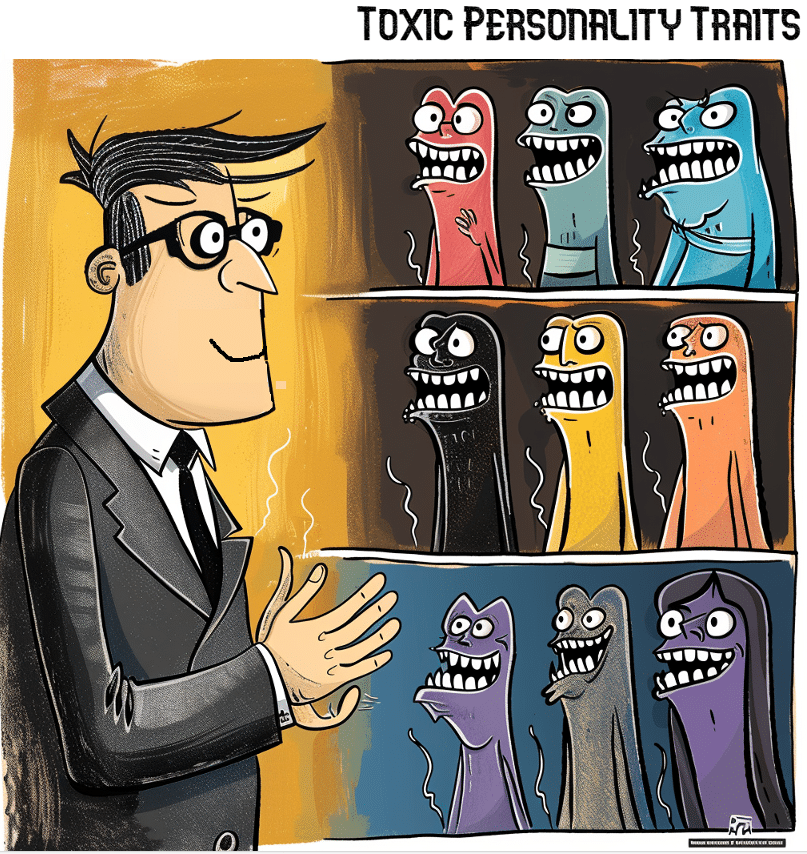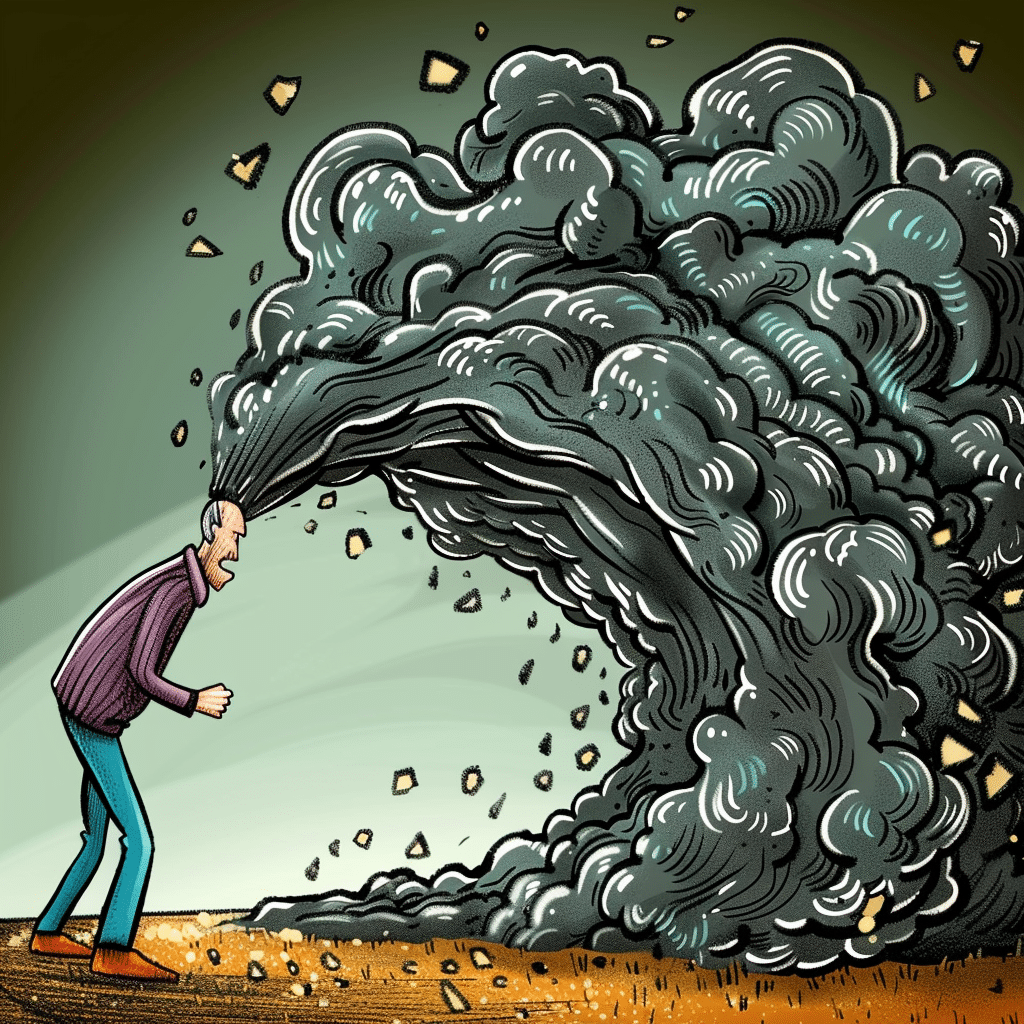“Leadership is not about being in charge. It’s about taking care of those in your charge.” – Simon Sinek
Unveiling the Monster: The Toxic Workplace Reality
In the world of workplace dynamics, a sinister presence sometimes lurks right under leadership’s nose, akin to the ‘Monster Under the Bed’ we all learned never existed to our parents, but was very real to us. While the monster of our childhood probably didn’t actually live under the bed, the tolerance of a destructive person in our midst in the workplace can feel to us much the same way we felt when we explained our nightmares to our parents. But this time the nightmare is still alive and well in the morning, has come to life from under that bed, and we’re living it. Every waking moment, whether we are actually standing next to it or at home eating dinner with our families. Toxic individuals cast long shadows and piles of destruction in their wakes, wreaking havoc on team morale, employee retention and productivity. They damage the health and well-being of others in the workplace. Their behaviors haunt us at home and seep into our parenting, “spousing,” and friending behaviors. We eat or don’t to regulate our emotions. Our waistlines, aches and pains, blood pressures, and lowered immunities show it. Piles of vitamins, diets, therapy, personal trainers…none of that fixes the problem.
We keep trying to fix the problem without addressing the root of the problem. Why? Because our fears of what could happen if we stand and face the nightmare authentically are way more catastrophic than the day-to-day drip of poison, we must endure while keeping the nightmare right where it is, roving around and randomly attacking our teammates and us. We enlarge the potential outcomes of fighting for ourselves and our workplace, we rationalize why that makes sense to protect others and our family’s financial security, and we build a long list of why it’s just not possible. Why do we do this? Because our reptilian brains (I visualize mine as a pet dragon named Daisy) would rather see us die than take risks. It is there to keep us safe and will make up all kinds of horrific stories to help us stick with the “nightmare we know,” rather than trying for one we don’t. But here’s the thing. Every moment you have to live on this planet, to breathe and experience your senses, to love and give and feel the joy of being part of the fabric of this tribe of humans, matters. Every moment. Tomorrow may not come. It’s now that matters.

The nightmare seeps into all aspects of our working life and into others who may not experience it directly. At the top, our CEO believes it’s not as bad as some of his people are telling him. Why? Because it’s a secret society of Misérables for the distinct purpose of not directly telling the CEO or anyone else who could punish us for daring to speak against the nightmare. Ok, to those of you reading this who are CEOs, who say to yourselves, “Oh, they tell me every day, and it’s not as bad as they say”….you believe that because they haven’t left you. Not yet. And if you highly value this person who is leaving dead bodies behind them in the hallways, they know it, and it’s not worth it to them to scream the truth from the mountain top, because you have conveyed that it’s not a welcome message or that you aren’t going to do anything about it. Not now. Maybe not ever. You have actually signed off on their secret society for your own rationalizations. And the nightmare thrives.
Often, we’ve convinced ourselves that our assigned nightmare of a human is the only human on the planet with the “secret sauce” for our products, our relationships, or our revenue. So we enter into a secret society of fellow Misérables, and we all share our stories, one-upping each other on who got the worst brunt of it each week, taking bets on who is next, joking about how the new favorite will soon find out what our nightmare really is and will join our esteemed society in a flurry of tears and wringing hands. We plan our retirements, or our next career moves and wonder if we can make it to our target dates for the money we need to get our kids through college, ourselves out of debt, or our resumes in sync with the next opportunity. Everything depends on surviving the nightmare.
Ready to banish the monsters for good?
PointerWise Workshops can help you improve your team’s dynamics.
Some Science on the Topic:
In Toxic Workplace!: Managing Toxic Personalities and Their Systems of Power by Mitchell Kusy and Elizabeth Holloway, the authors provide a framework for how to address the worst kind of toxic conflict – the kind that comes from a broken person who needs far more help than is typically available to work productively with other human beings. The book is an insightful exploration into the complexities of toxic personalities in the workplace and provides a comprehensive examination of how toxic individuals, through their behavior and influence, can impact organizational culture, employee well-being, and overall productivity.
- Identification of Toxic Personalities: The authors delve into the various characteristics of toxic individuals in the workplace. These personalities are often manipulative, self-centered, and prone to undermining others. They possess an uncanny ability to charm and deceive, making their toxicity hard to detect initially.
- Impact on the Workplace: The book emphasizes the significant negative impact that toxic individuals can have on their colleagues and the broader organizational environment. This includes reduced employee morale, increased stress levels, and a decline in team cohesion and productivity.
- Power Dynamics: Kusy and Holloway explore how toxic individuals exploit organizational structures and power dynamics to maintain their influence and control. They often maneuver themselves into positions where they can exert power over others, further exacerbating the toxicity.
- Strategies for Individuals and Leaders: A crucial part of the book focuses on strategies for individuals and leaders to recognize, confront, and manage toxic behaviors. This includes setting boundaries, fostering a culture of open communication, and implementing effective conflict-resolution practices.
- Organizational Change: The authors advocate for systemic changes within organizations to address and prevent toxicity. They suggest implementing policies and training programs aimed at raising awareness about toxic behaviors and creating a supportive and respectful work environment.
- Case Studies and Real-World Examples: Throughout the book, Kusy and Holloway enrich their discussion with real-world examples and case studies, providing practical insights and demonstrating the real-life impact of toxic workplace dynamics.
- Long-Term Solutions: The book concludes with a focus on long-term solutions, emphasizing the importance of ongoing vigilance, continuous learning, and the development of a positive organizational culture that actively discourages toxic behavior.
The Many Impacts of Workplace Toxicity
 Toxicity in the workplace manifests in various forms – from the subtly undermining colleague to the overtly aggressive manager. These individuals, skilled in manipulation and often charming, wield their influence in ways that erode team cohesion and individual well-being. Kusy and Holloway’s research underscores that the impact of toxic behaviors extends far beyond interpersonal conflicts, affecting overall organizational health.
Toxicity in the workplace manifests in various forms – from the subtly undermining colleague to the overtly aggressive manager. These individuals, skilled in manipulation and often charming, wield their influence in ways that erode team cohesion and individual well-being. Kusy and Holloway’s research underscores that the impact of toxic behaviors extends far beyond interpersonal conflicts, affecting overall organizational health.
When discussing the impacts of a toxic person in the workplace, there are several scientific studies and academic sources that provide valuable insights. Here are some key studies and their findings:
- Impact on Employee Mental Health and Well-being: A study published in the Journal of Applied Psychology found that exposure to workplace bullying and toxic behavior significantly increases the risk of mental health issues in employees, including stress, anxiety, and depression. Rayner, C., & Keashly, L. (2005). Bullying at work: A perspective on its development and study. Journal of Applied Psychology, 90(3), 486-499.
- Effects on Team Performance and Productivity: Research conducted by Pearson and Porath in their book The Cost of Bad Behavior highlights that employees’ productivity decreases when exposed to incivility in the workplace. The study found that 48% of employees intentionally decreased their work effort due to incivility. Pearson, C. M., & Porath, C. L. (2009). The cost of bad behavior. Organizational Dynamics, 38(1), 64-71.
- Turnover and Talent Drain: A study by the Society for Human Resource Management (SHRM) reveals that toxic workplace cultures lead to increased turnover, with 1 in 5 Americans leaving their jobs due to bad company culture in the past five years. Society for Human Resource Management (2019). Toxic workplace cultures are driving turnover [Press release].
- Impact on Physical Health: Research published in the Journal of Occupational and Environmental Medicine indicates that employees exposed to a toxic work environment experience higher levels of stress, which can lead to physical health problems such as hypertension and cardiovascular disease. Kivimäki, M., et al. (2006). Work stress in the etiology of coronary heart disease—a meta-analysis. Scand J Work Environ Health, 32(6), 431-442.
- Legal and Reputation Risks: A report by the Equal Employment Opportunity Commission (EEOC) highlights the legal implications of toxic behaviors, especially when they involve harassment or discrimination, and how they can lead to lawsuits and damage to the company’s reputation. U.S. Equal Employment Opportunity Commission (2016). Select Task Force on the Study of Harassment in the Workplace.
These sources provide a scientific and empirical basis for accepting that the multi-dimensional impacts of toxic individuals in the workplace is not just a figment of the imaginations of “overly sensitive” individuals who don’t “have what it takes” to make it in the rough and tumble corporate world. That’s all the BS that toxic people want us to believe! They underscore the importance of proactive measures in identifying and addressing such behaviors to maintain a healthy and productive work environment.
So How Does the Toxic Person Think?
 To be sure, it’s not really our responsibility or appropriate territory to inquire into why a person in our workplace regularly exhibits toxic behaviors. But still, we wonder why, and we tend to dehumanize those people, which isn’t good for anybody. Particularly anybody who has to communicate with them directly about their behaviors. While it’s never EVER a good idea to attempt arm-chair psychoanalysis without that license on the wall and a clear patient-mental healthcare provider relationship, understanding some of the basic and likely scenarios can help us calm down a bit and find the empathy we need to manage someone for whom we feel subzero natural empathy. Before I start this part, let me be perfectly clear about one thing. We should NEVER label anyone with psychological diagnostic terms, whether we know or don’t know about their actual diagnoses. Using such language in the workplace in communicating with that person or with others about them is legally dangerous and otherwise simply disrespectful. When you feel invited to be disrespectful by the individual’s toxic behavior, turn down that invitation. It’s a party you don’t want to attend.
To be sure, it’s not really our responsibility or appropriate territory to inquire into why a person in our workplace regularly exhibits toxic behaviors. But still, we wonder why, and we tend to dehumanize those people, which isn’t good for anybody. Particularly anybody who has to communicate with them directly about their behaviors. While it’s never EVER a good idea to attempt arm-chair psychoanalysis without that license on the wall and a clear patient-mental healthcare provider relationship, understanding some of the basic and likely scenarios can help us calm down a bit and find the empathy we need to manage someone for whom we feel subzero natural empathy. Before I start this part, let me be perfectly clear about one thing. We should NEVER label anyone with psychological diagnostic terms, whether we know or don’t know about their actual diagnoses. Using such language in the workplace in communicating with that person or with others about them is legally dangerous and otherwise simply disrespectful. When you feel invited to be disrespectful by the individual’s toxic behavior, turn down that invitation. It’s a party you don’t want to attend.
Here’s a bit of admittedly superficial information to explore further as you deem helpful, for purposes of understanding why the toxic person behaves like they do in the workplace:
Psychological Traits and Origins of Toxic Behavior
- Narcissism and Power Dynamics: A common trait observed in toxic individuals is narcissism. A study by O’Reilly et al. (2014) in the Academy of Management Perspectives shows that narcissistic individuals often rise to leadership positions. Their sense of entitlement and superiority can lead to toxic behaviors like bullying and manipulation. O’Reilly, C. A., Doerr, B., Caldwell, D. F., & Chatman, J. A. (2014). Narcissistic CEOs and executive compensation. Academy of Management Perspectives, 28(1), 121-143.
- Lack of Emotional Intelligence: People exhibiting toxic behaviors often have low emotional intelligence, particularly in empathy. A study by Côté et al. in the journal Psychological Science found that individuals with lower emotional intelligence are less adept at recognizing and responding to others’ emotions, contributing to interpersonal conflicts. Côté, S., Miners, C. T. H., & Greenbaum, R. L. (2006). Emotional intelligence, cognitive intelligence, and job performance. Administrative Science Quarterly, 55(1), 1-28.
Self-Perception and Denial
- Cognitive Dissonance and Rationalization: Toxic individuals may not view their behavior as harmful. The concept of cognitive dissonance, as discussed in Festinger’s theory, suggests that these individuals often rationalize their actions to align with their self-perception, ignoring the negative impact on others. Festinger, L. (1957). A Theory of Cognitive Dissonance. Stanford University Press.
- Fear of Vulnerability: A study by Brown (2006) in the Journal of Personality and Social Psychology posits that toxic behavior can stem from a fear of vulnerability. Individuals may adopt aggressive or domineering behaviors as a defense mechanism to protect themselves from perceived threats. Brown, B. (2006). Shame resilience theory: A grounded theory study on women and shame. Families in Society, 87(1), 43-52.
Challenges in Changing Toxic Behaviors
- Resistance to Feedback: According to research by Finkelstein (2003) in the Harvard Business Review, toxic individuals often resist feedback due to overconfidence and a lack of self-awareness. This resistance makes it challenging to initiate behavioral change. Finkelstein, S. (2004). Why Smart Executives Fail. Harvard Business Review, 81(6), 72-80.
- Reinforcement by Organizational Culture: If a toxic individual’s behavior is implicitly condoned or rewarded by the organizational culture, it reinforces their actions. A study by Appelbaum et al. in the International Journal of Business and Social Science highlights how organizational culture can perpetuate toxic behavior. Appelbaum, S. H., Iaconi, G. D., & Matousek, A. (2007). Positive and negative deviant workplace behaviors: causes, impacts, and solutions. Corporate Governance, 7(5), 586-598.
Strategies for Employees: Navigating the Toxic Colleague
 For those of us who have no power to manage the toxic individual in our midst, here are a few tips to help you survive while you are hopefully planning how to address the problem in more productive ways than eating an entire bowl of chocolate ice cream before bed:
For those of us who have no power to manage the toxic individual in our midst, here are a few tips to help you survive while you are hopefully planning how to address the problem in more productive ways than eating an entire bowl of chocolate ice cream before bed:
- Recognizing Toxic Traits: Employees must first be able to identify toxic behaviors – constant negativity, manipulation, and undermining of others are key indicators. Understanding these traits helps in differentiating normal workplace stress from harmful interactions.
- Establishing Boundaries: Just as Kusy and Holloway advocate, setting clear personal boundaries is essential. It involves consciously deciding what behaviors one will and will not tolerate and sticking to these limits. If the toxic person is your boss, this is easier said than done. Your boundaries will have to be supported by others, such as your HR organization. And if that’s not possible, I suggest finding a new home where such boundaries are unnecessary!
- Documenting Interactions: Keeping a record of toxic interactions provides tangible evidence of the behavior, crucial for any formal complaint process.
- Seeking Support Systems: Building a network of supportive colleagues, HR representatives, and superiors can provide the necessary backing in addressing toxic situations.
Tired of the nightmare?
Let us help you uncover the monster under the bed with Workplace Investigations.
Leadership’s Role: Illuminating and Eradicating Toxicity
For leaders who understand that the toxic person’s behavior must be dealt with effectively, directly and with unvarnished, unwavering commitment, here are some tips for you:
- Creating Open Communication Channels: Leaders must foster an environment where employees feel safe to voice concerns. Open communication not only brings hidden issues to light but also helps in building trust within the team. Always remember that an open channel and listening is nothing without the next key action point, accountability. Is just allowing people to safely vent without taking action designed to solve the problem? Well, it’s not leadership. It’s hiding.
- Enforcing Accountability: As Kusy and Holloway suggest, leaders need to enforce a zero-tolerance policy towards toxic behavior. This involves setting clear expectations and following through with consequences for harmful actions. This means you may have to terminate a toxic individual or otherwise separate them from the team at inconvenient times and with outcomes that are undesirable for the business’s bottom line in the short term.
- Proactive Observation and Intervention: Leaders should be proactive in identifying and addressing toxic behaviors. This requires a keen observation of team dynamics and the courage to take timely action. In other words, don’t wait for the problem to be presented to you on a silver platter by a courageous person or a person who serves their resignation letter at the same time.
- Providing Pathways for Change: While it’s not a leader’s job to fix toxic individuals, providing resources for personal development and professional growth can facilitate positive changes. Sometimes, Employee Assistance Programs or other customized support measures can have a great impact on a toxic leader. But only if that leader is actually open to and accepting of the need to change. Without that, you are wasting your money. And the truth is that sometimes the damage done is so severe that the team will not accept anything less than never having to work with that person again.
Shining a Light on Toxic Conflict Caused by Toxic Behaviors
 The unhealthy, personal conflict we experience at work often arises from the collective inability to be vulnerable, disclose our weaknesses and mistakes, and engage each other authentically without personal agendas. But sometimes, it is a symptom of an onslaught of toxic and damaging behaviors by one or more persons. Clear-eyed identification and acceptance of the problem combined with unflinching devotion to accountability, regardless of (or even because of) a person’s high-level role in an organization, are crucial to banishing the “Monster Under the Bed” to where it belongs. In the world of imagination and nightmares and not in the office next door.
The unhealthy, personal conflict we experience at work often arises from the collective inability to be vulnerable, disclose our weaknesses and mistakes, and engage each other authentically without personal agendas. But sometimes, it is a symptom of an onslaught of toxic and damaging behaviors by one or more persons. Clear-eyed identification and acceptance of the problem combined with unflinching devotion to accountability, regardless of (or even because of) a person’s high-level role in an organization, are crucial to banishing the “Monster Under the Bed” to where it belongs. In the world of imagination and nightmares and not in the office next door.
Reflective Considerations:
- How can organizations implement ongoing training and awareness programs to help employees and leaders recognize and manage toxic behaviors?
- What role do external counselors or consultants play in addressing systemic toxicity within an organization?
- How can feedback mechanisms be structured to regularly assess and address the health of workplace relationships?
“You know, it’s hard to sleep when you’re afraid that the monster under your bed will eat you…But it’s harder when you realize he only wants to borrow a cup of sugar at 3 AM.” – Ellen DeGeneres
Don’t let toxic behaviors haunt your workplace.
Discover how PointerWise can help by reaching out today!






